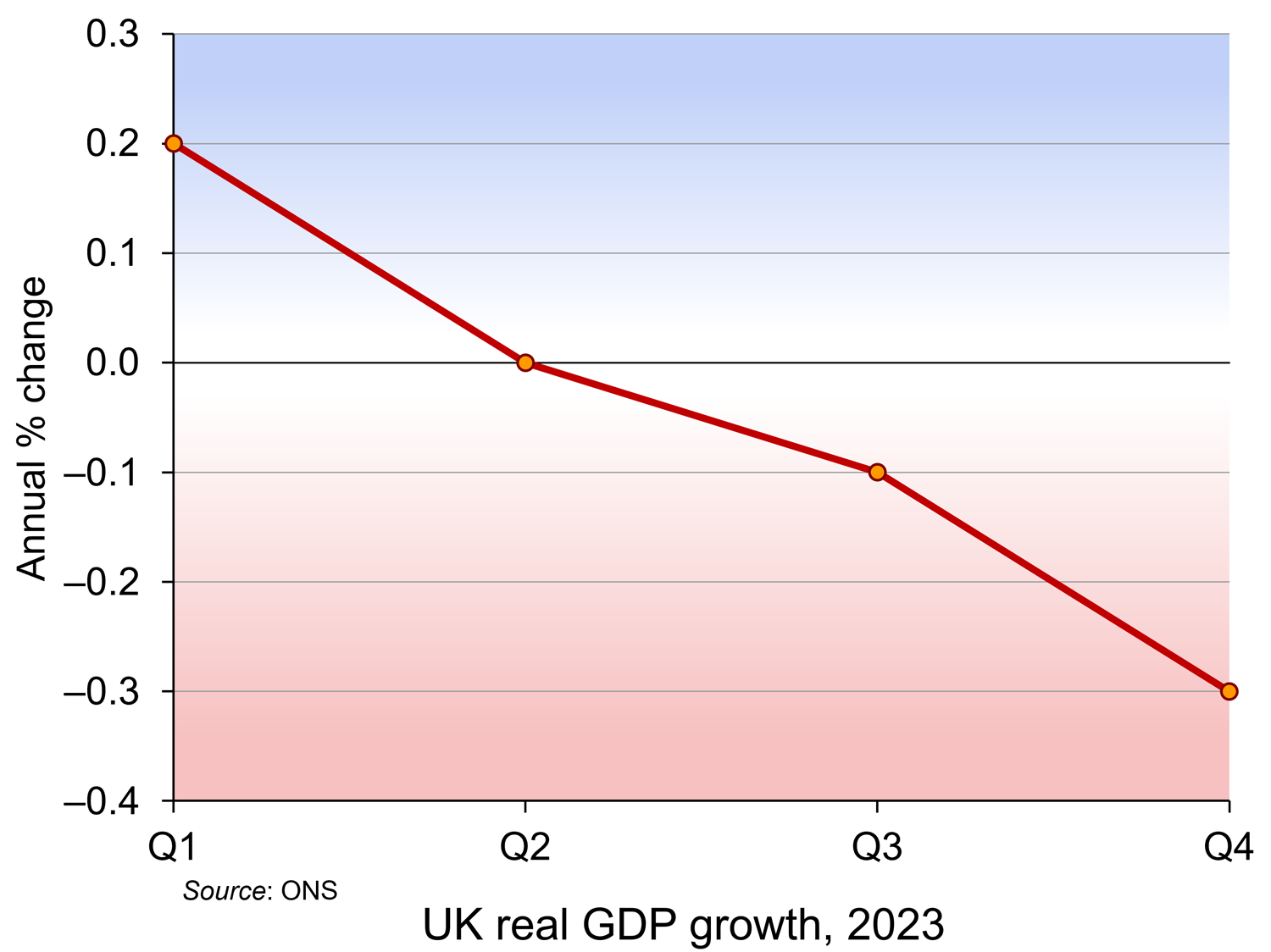 Latest figures from the Office for National Statistics show that the UK was in recession at the end of 2023. The normal definition of recession is two quarters of falling real GDP. This is what happened to the UK in the last two quarters of 2023, with GDP falling by 0.1% in Q3 and 0.3% in Q4. In Q4, output of the service industries fell by 0.2%, production industries by 1.0% and construction by 1.3%.
Latest figures from the Office for National Statistics show that the UK was in recession at the end of 2023. The normal definition of recession is two quarters of falling real GDP. This is what happened to the UK in the last two quarters of 2023, with GDP falling by 0.1% in Q3 and 0.3% in Q4. In Q4, output of the service industries fell by 0.2%, production industries by 1.0% and construction by 1.3%.
But how bad is this? What are the implications for living standards? In some respects, the news is not as bad as the term ‘recession’ might suggest. In other respects, it’s worse than the headline figures might imply.
The good news (or not such bad news)
The first thing to note is that other countries too experienced a recession or slowdown in the second half of 2023. So, relative to these countries, the UK is not performing that badly. Japan, for example, also experienced a mild recession; Germany just missed one. These poor economic growth rates were caused largely by higher global energy and food prices and by higher central bank interest rates in response. The good news is that such cost pressures are already easing.
The second piece of good news is that GDP is expected to start growing again (modestly) in 2024. This will be helped by the Bank of England cutting interest rates. The Monetary Policy Committee is expected to do this at its May, June or August meetings provided that inflation falls. Annual CPI inflation was 4% in January – the same as in December. But it is expected to fall quite rapidly over the coming months provided that there are no serious supply-side shocks (e.g. from world political factors).
The third is that the recession is relatively modest compared with ones in the past. In the recession following the financial crisis, real GDP fell by 5.3% in 2009; during the pandemic, GDP fell by 10.7% in 2020. For this reason, some commentators have said that the last two quarters of 2023 represent a mere ‘technical recession’, with the economy expected to grow again in 2024.
Why things may be worse than the headline figures suggest
Real GDP per head
So far we have considered real GDP (i.e. GDP adjusted for inflation). But if changes in GDP are to reflect changes in living standards, we need to consider real GDP per head. Population is rising. This means that the rate of growth in real GDP per head is lower than the rate of growth in real GDP
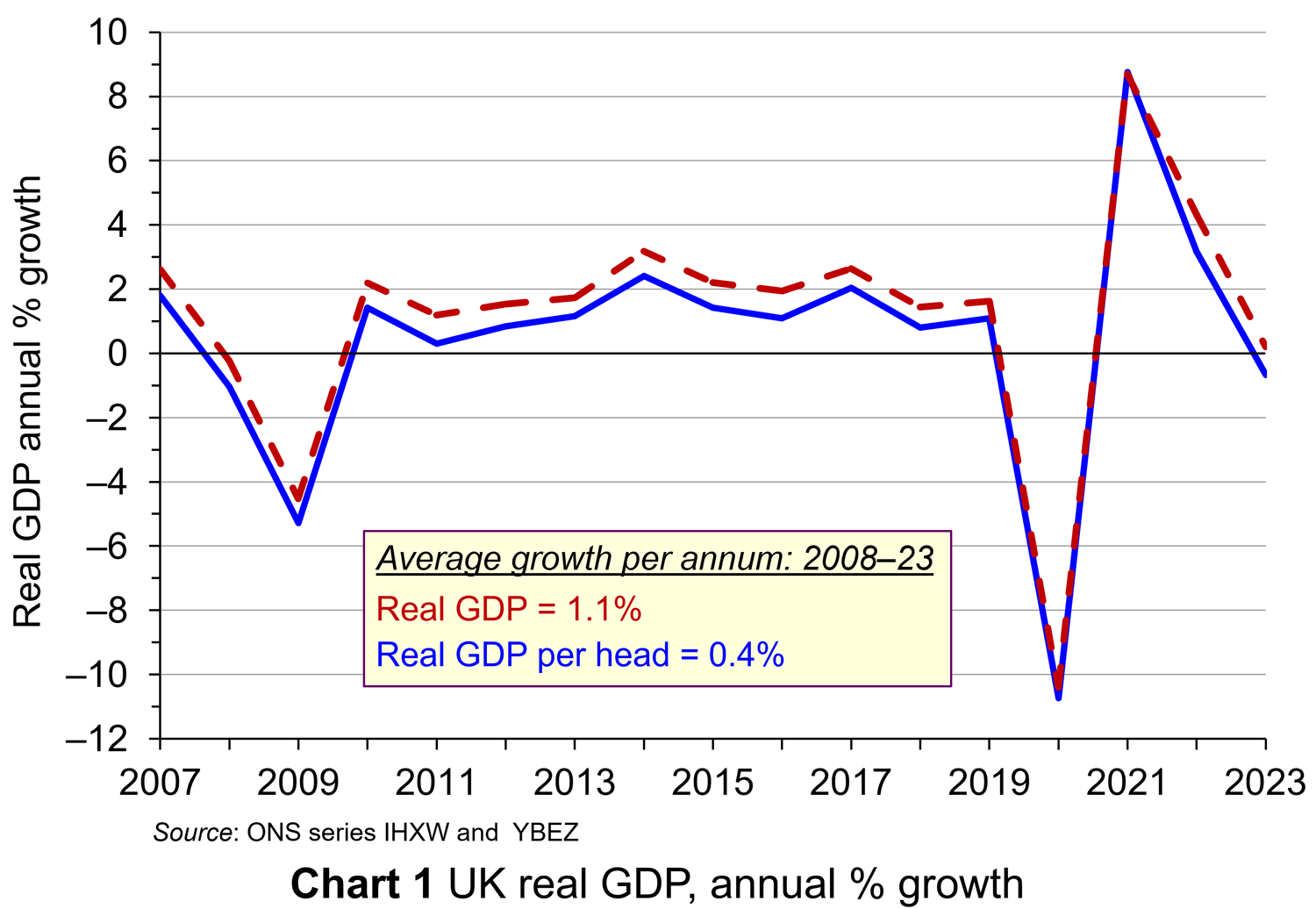 For 2023 as a whole, while real GDP rose by 0.20%, real GDP per head fell by 0.67%. In the last two quarters of 2023, while real GDP fell by 0.1% and 0.3% respectively, real GDP per head fell by 0.4% and 0.6%, respectively, having already fallen in each of the previous five quarters. Chart 1 shows real GDP growth and real GDP growth per head from 2007 to 2023 (click here for a PowerPoint). As you can see, given population growth, real GDP per head has consistently grown slower than real GDP.
For 2023 as a whole, while real GDP rose by 0.20%, real GDP per head fell by 0.67%. In the last two quarters of 2023, while real GDP fell by 0.1% and 0.3% respectively, real GDP per head fell by 0.4% and 0.6%, respectively, having already fallen in each of the previous five quarters. Chart 1 shows real GDP growth and real GDP growth per head from 2007 to 2023 (click here for a PowerPoint). As you can see, given population growth, real GDP per head has consistently grown slower than real GDP.
Long-term trends.
If we are assessing the UK’s potential for growth in GDP, rather than the immediate past, it is useful to look at GDP growth over a longer period. Looking at past trend growth rates and explaining them can give us an indication of the likely future path of the growth in GDP – at least in the absence of a significant change in underlying economic factors. Since 2007, the average annual rate of growth of real GDP has been only 1.1% and that of real GDP per head a mere 0.4%.
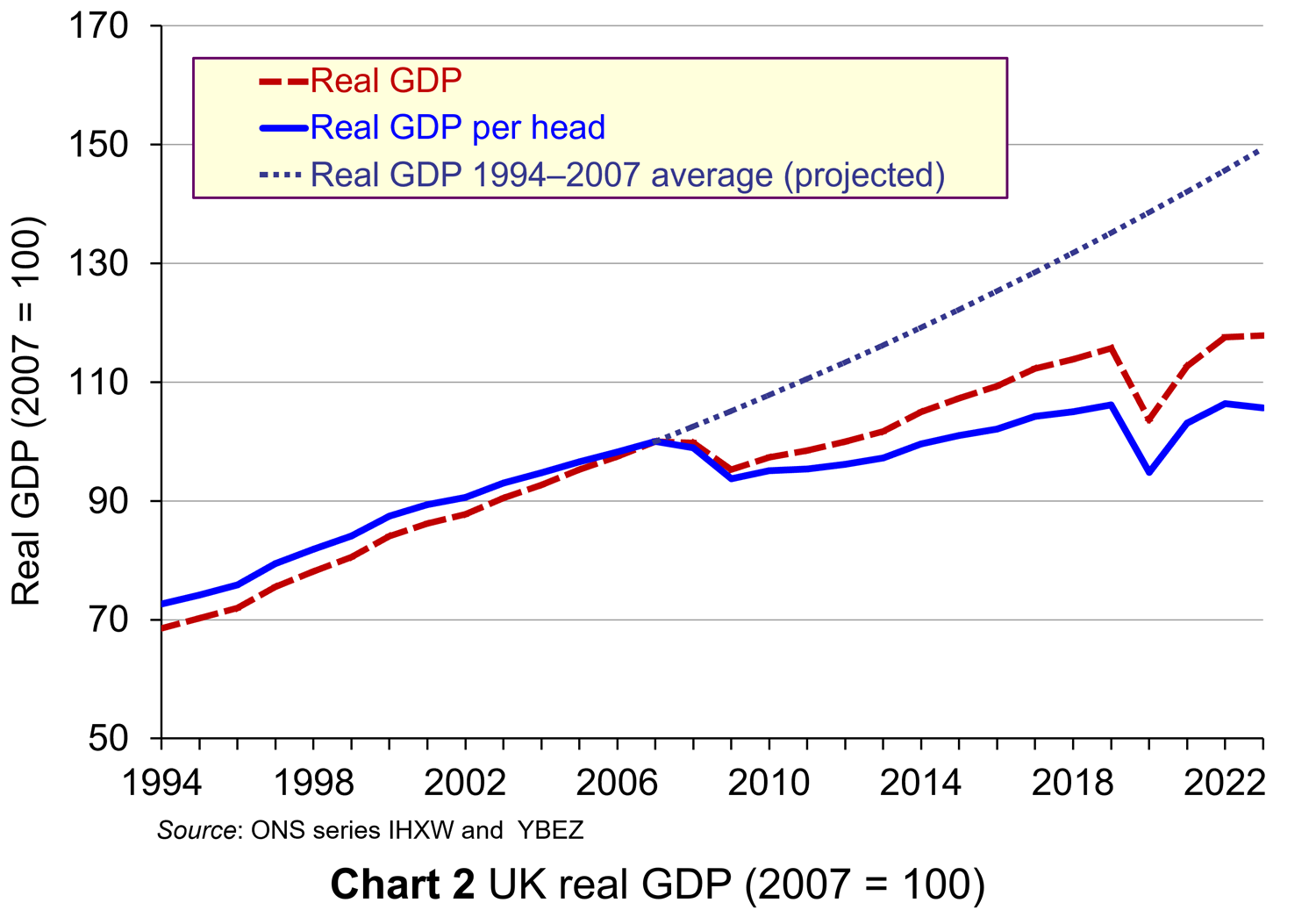 This compares unfavourably with the period from 1994 to 2007, when the average annual rate of growth of real GDP was 3.0% and that of real GDP per head was 2.5%.
This compares unfavourably with the period from 1994 to 2007, when the average annual rate of growth of real GDP was 3.0% and that of real GDP per head was 2.5%.
This is illustrated in Chart 2 (click here for a PowerPoint). The chart also projects the growth rate in GDP per head of 2.5% forward from 2007 to 2023. Had this growth rate been achieved since 2007, GDP per head in 2023 would have been 41.4% higher than it actually was.
It is not only the UK that has seen low growth over the past 15 years compared to previous years. It has achieved a similar average annual growth rate over the period to Germany (1.1%), lower rates than the USA (1.8%) and Canada (1.6%), but higher than France (0.9%) and Japan (0.4%).
Low investment
A key determinant of economic growth is investment. Since 2008, the UK has invested an average of 17.3% of GDP. This is the lowest of the G7 countries and compares with 24.9% in Japan, 23.7% in Canada, 23.5% in France, 21.3% in Germany, 20.4% in the USA and 19.1% in Italy. If UK growth is to recover strongly over the longer term, the rate of investment needs to increase, both private and public. Of course, investment has to be productive, as the key underlying determinant of economic growth is the growth in productivity.
Low productivity growth
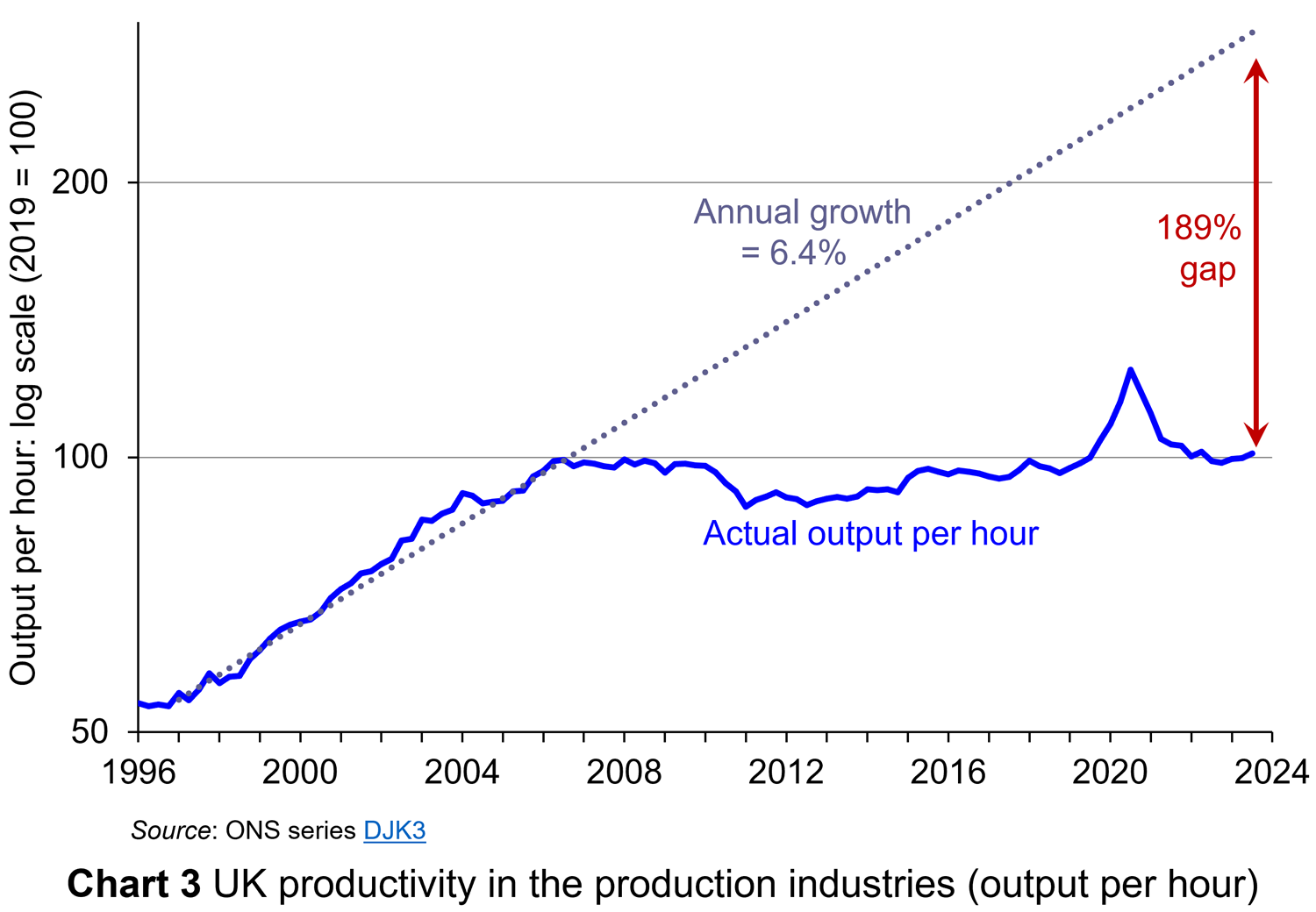 This is a key issue for the government – how to encourage a growth in productivity. The UK’s record of productivity growth has been poor since 2008. The period from 1996 to 2006 saw an average annual growth in labour productivity of 6.4%. Since then, however, labour productivity has grown by an average annual rate of only 0.3%. This is illustrated in Chart 3 (click here for a PowerPoint). If the pre-2007 rate had continued to the end of 2023, labour productivity would be 189% higher. This would have made GDP per head today substantially higher. If GDP per head is to grow faster, then the underlying issue of a poor growth in labour productivity will need to be addressed.
This is a key issue for the government – how to encourage a growth in productivity. The UK’s record of productivity growth has been poor since 2008. The period from 1996 to 2006 saw an average annual growth in labour productivity of 6.4%. Since then, however, labour productivity has grown by an average annual rate of only 0.3%. This is illustrated in Chart 3 (click here for a PowerPoint). If the pre-2007 rate had continued to the end of 2023, labour productivity would be 189% higher. This would have made GDP per head today substantially higher. If GDP per head is to grow faster, then the underlying issue of a poor growth in labour productivity will need to be addressed.
Inequality and poverty
Then there is the issue of the distribution of national income. The UK has a high level of income inequality. In 2022 (the latest data available), the disposable income of the poorest 20% of households was £13 218; that for the richest 20% was £83 687.  The top 1% of income earners’ share of disposable income is just under 9.0%. (Note that disposable income is after income taxes have been deducted and includes cash benefits and is thus more equally distributed than original income.)
The top 1% of income earners’ share of disposable income is just under 9.0%. (Note that disposable income is after income taxes have been deducted and includes cash benefits and is thus more equally distributed than original income.)
The poorest 20% have been hit badly by the cost-of-living crisis, with many having to turn to food banks and not being able to afford to heat their homes adequately. They are also particularly badly affected by the housing crisis, with soaring and increasingly unaffordable rents. Many are facing eviction and others live in poor quality accommodation. Simple growth rates in real GDP do not capture such issues.
Limited scope for growth policies
Fiscal policy has an important role in stimulating growth. Conservatives stress tax cuts as a means of incentivising entrepreneurs and workers. Labour stresses the importance of public investment in infrastructure, health, education and training. Either way, such stimulus policy requires financing.
 But, public finances have been under pressure in recent years, especially from COVID support measures. General government gross debt has risen from 27.7% of GDP in 1990/91 to 99.4% in 2022/23. This is illustrated in Chart 4 (click here for a PowerPoint). Although it has fallen from the peak of 107.6% of GDP in 2020/21 (during the COVID pandemic), according to the Office for Budget Responsibility it is set to rise again, peaking at 103.8% in 2026/27. There is thus pressure on the government to reduce public-sector borrowing, not increase it. This makes it difficult to finance public investment or tax cuts.
But, public finances have been under pressure in recent years, especially from COVID support measures. General government gross debt has risen from 27.7% of GDP in 1990/91 to 99.4% in 2022/23. This is illustrated in Chart 4 (click here for a PowerPoint). Although it has fallen from the peak of 107.6% of GDP in 2020/21 (during the COVID pandemic), according to the Office for Budget Responsibility it is set to rise again, peaking at 103.8% in 2026/27. There is thus pressure on the government to reduce public-sector borrowing, not increase it. This makes it difficult to finance public investment or tax cuts.
Measuring living standards
Questions about real GDP have huge political significance. Is the economy in recession? What will happen to growth in GDP over the coming months. Why has growth been sluggish in recent years? The implication is that if GDP rises, living standards will rise; if GDP falls, living standards will fall. But changes in GDP, even if expressed in terms of real GDP and even if the distribution of GDP is taken into account, are only a proxy for living standards. GDP measures the market value of the output of goods and services and, as such, may not necessarily be a good indicator of living standards, let alone well-being.
Produced goods and services that are not part of GDP
 The output of some goods and services goes unrecorded. As we note in Economics, 11e (section 15.2), “If you employ a decorator to paint your living room, this will be recorded in the GDP statistics. If, however, you paint the room yourself, it will not. Similarly, if a childminder is employed by parents to look after their children, this childcare will form part of GDP. If, however, a parent stays at home to look after the children, it will not.
The output of some goods and services goes unrecorded. As we note in Economics, 11e (section 15.2), “If you employ a decorator to paint your living room, this will be recorded in the GDP statistics. If, however, you paint the room yourself, it will not. Similarly, if a childminder is employed by parents to look after their children, this childcare will form part of GDP. If, however, a parent stays at home to look after the children, it will not.
The exclusion of these ‘do-it-yourself’ and other home-based activities means that the GDP statistics understate the true level of production in the economy. If over time there is an increase in the amount of do-it-yourself activities that people perform, the figures will also understate the rate of growth of national output.” With many people struggling with the cost of living, such a scenario is quite likely.
There are also activities that go unrecorded in the ‘underground’ or ‘shadow’ economy: unemployed people doing casual jobs for cash in hand that they do not declare to avoid losing benefits; people doing extra work outside their normal job and not declaring the income to evade taxes; builders doing work for cash to save the customer paying VAT.
Externalities
 Large amounts of production and consumption involve external costs to the environment and to other people. These externalities are not included in the calculation of GDP.
Large amounts of production and consumption involve external costs to the environment and to other people. These externalities are not included in the calculation of GDP.
If external costs increase faster than GDP, then GDP growth will overstate the rise in living standards. If external costs rise more slowly than GDP (or even fall), then GDP growth will understate the rise in living standards. We assume here that living standards include social and environmental benefits and are reduced by social and environmental costs.
Human costs of production
If production increases as a result of people having to work harder or longer hours, its net benefit will be less. Leisure is a desirable good, and so too are pleasant working conditions, but these items are not included in the GDP figures.
The production of certain ‘bads’ leads to an increase in GDP
 Some of the undesirable effects of growth may in fact increase GDP! Take the examples of crime, stress-related illness and environmental damage. Faster growth may lead to more of all three. But increased crime leads to more expenditure on security; increased stress leads to more expenditure on health care; and increased environmental damage leads to more expenditure on environmental clean-up. These expenditures add to GDP. Thus, rather than reducing GDP, crime, stress and environmental damage actually increase it.
Some of the undesirable effects of growth may in fact increase GDP! Take the examples of crime, stress-related illness and environmental damage. Faster growth may lead to more of all three. But increased crime leads to more expenditure on security; increased stress leads to more expenditure on health care; and increased environmental damage leads to more expenditure on environmental clean-up. These expenditures add to GDP. Thus, rather than reducing GDP, crime, stress and environmental damage actually increase it.
Alternative approaches to measuring production and income
There have been various attempts to adjust GDP (actual or potential) to make it a better indicator of total production or income or, more generally, of living standards.
Index of Sustainable Economic Welfare (ISEW)
As Case Study 9.20 in the Essentials of Economics (9e) website explains, ISEW starts with consumption, as measured in GDP, and then makes various adjustments to account for factors that GDP ignores. These include:
- Inequality: the greater the inequality, the more the figure for consumption is reduced. This is based on the assumption of a diminishing marginal utility of income, such that an additional pound is worth less to a rich person than to a poor person.
- Household production (such as childcare, care for the elderly or infirm, housework and various do-it-yourself activities). These ‘services of household labour’ add to welfare and are thus entered as a positive figure.
- Defensive expenditures. This is spending to offset the adverse environmental effects of economic growth (e.g. asthma treatment for sufferers whose condition arises from air pollution). Such expenditures are taken out of the calculations.
- ‘Bads’ (such as commuting costs). The monetary expense entailed is entered as a negative figure (to cancel out its measurement in GDP as a positive figure) and then an additional negative element is included for the stress incurred.
- Environmental costs. Pollution is entered as a negative figure.
- Resource depletion and damage. This too is given a negative figure, in just the same way that depreciation of capital is given a negative figure when working out net national income.
Productive Capacities Index (PCI)
In 2023, the United Nations Conference on Trade and Development (UNCTAD) launched a new index to provide a better measure of countries’ economic potential. What the index focuses on is not actual GDP but potential output: in other words, ‘countries’ abilities to produce goods and deliver services’.
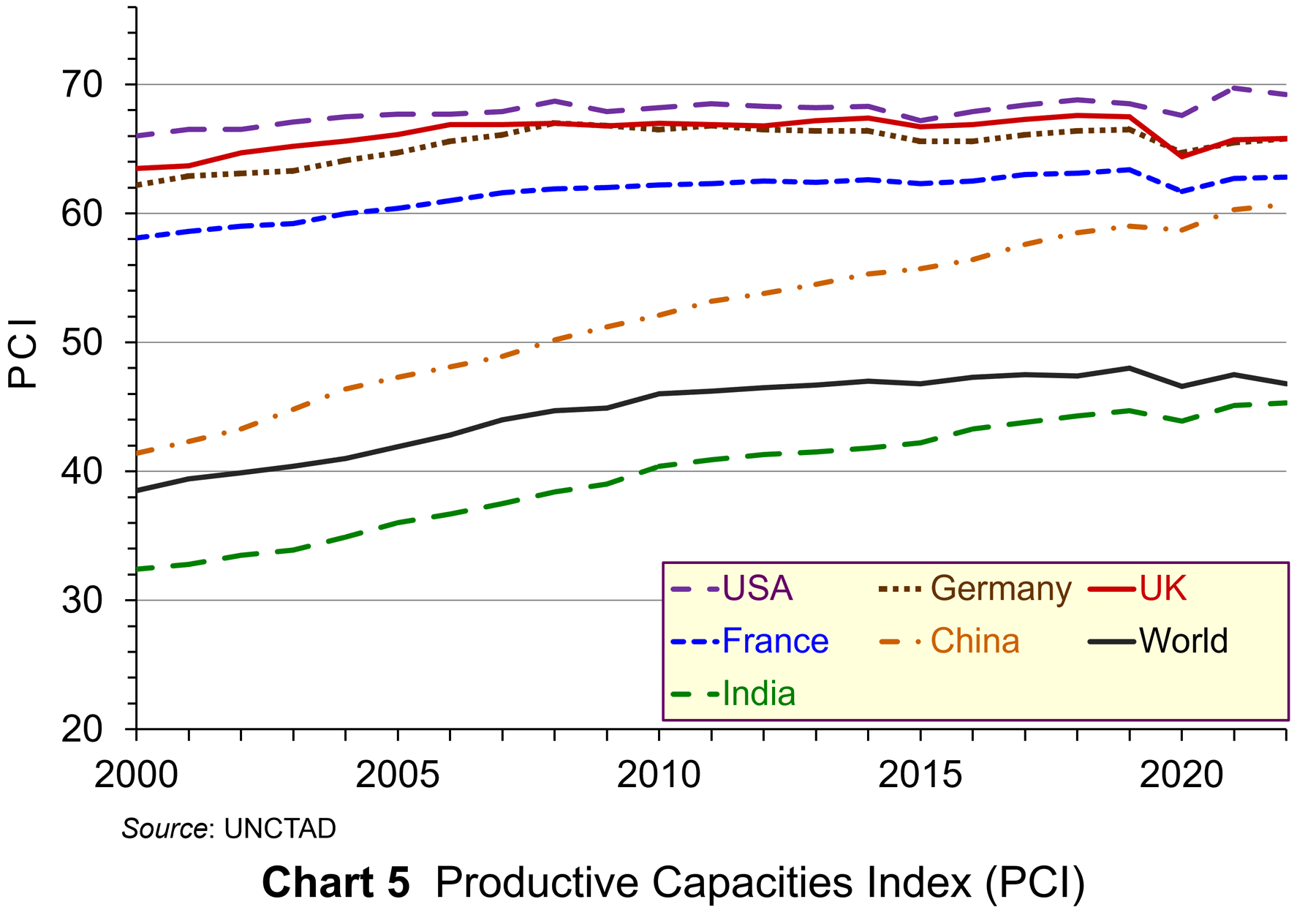 The PCI comprises 42 indicators under eight headings: human capital, natural capital, information and communication technology (ICT), structural change (the movement of labour and other productive resources from low-productivity to high-productivity economic activities), transport infrastructure, institutions (political, legal and financial) and the private sector (ease of starting businesses, availability of credit, ease of cross-border trade, etc.). It covers 194 economies since 2000 (currently to 2022). As UNCTAD states, ‘The PCI can help diagnose the areas where countries may be leading or falling behind, spotlighting where policies are working and where corrective efforts are needed.’ Chart 5 shows the PCI for various economies from 2000 to 2022 (click here for a PowerPoint).
The PCI comprises 42 indicators under eight headings: human capital, natural capital, information and communication technology (ICT), structural change (the movement of labour and other productive resources from low-productivity to high-productivity economic activities), transport infrastructure, institutions (political, legal and financial) and the private sector (ease of starting businesses, availability of credit, ease of cross-border trade, etc.). It covers 194 economies since 2000 (currently to 2022). As UNCTAD states, ‘The PCI can help diagnose the areas where countries may be leading or falling behind, spotlighting where policies are working and where corrective efforts are needed.’ Chart 5 shows the PCI for various economies from 2000 to 2022 (click here for a PowerPoint).
The UK, with a PCI of 65.8 in 2022, compares relatively favourably with other developed countries. The USA’s PCI is somewhat higher (69.2), as is The Netherlands’ (69.8); Germany’s is the same (65.8); France’s is somewhat lower (62.8). The world average is 46.8. For developing countries, China is relatively high (60.7); India’s (45.3) is close to the developing country average of 43.4.
Looked at over a longer time period, the UK’s performance is relatively weak. The PCI in 2022 (65.8) was below that in 2006 (66.9) and below the peak of 67.6 in 2018.
GDP and well-being
GDP is often used as a proxy for well-being. If real GDP per head increases, then it is assumed that well-being will increase. In practice, people’s well-being depends on many factors, not just their income, although income is one important element.
The UK Measuring National Well-being (MNW) programme
 The MNW programme was established in 2010. This has resulted in Office for National Statistics developing new measures of national well-being. The ONS produces statistical bulletins and datasets with its latest results.
The MNW programme was established in 2010. This has resulted in Office for National Statistics developing new measures of national well-being. The ONS produces statistical bulletins and datasets with its latest results.
The aim of the programme is to provide a ‘fuller picture’ of how society is doing beyond traditional economic indicators. There are currently 44 indicators. These are designed to describe ‘how we are doing as individuals, as communities and as a nation, and how sustainable this is for the future’. The measures fall within a number of categories, including: personal well-being, relationships, health, what we do, where we live, personal finance, the economy, education and skills, governance and the natural environment.
Conclusions
In the light of the limitations of GDP as a measure of living standards, what can we make of the news that the UK entered recession in the last half of 2023? It does show that the economy is sluggish and that the production of goods and services that are included in the GDP measure declined.
But to get a fuller assessment of the economy, it is important to take a number of other factors into account. If we are to go further and ask what has happened to living standards or to well-being, then we have to look at a range of other factors. If we are to ask what the latest figures tell us about what is likely to happen in the future to production, living standards and well-being, then we will need to look further still.
Articles
- Britain falls into recession, with worst GDP performance in 2023 in years
CNN, Hanna Ziady (15/2/24)
- UK economy slipped into recession in 2023
Financial Times, Valentina Romei and George Parker (15/2/24)
- UK economy fell into recession after people cut spending
BBC News, Dearbail Jordan & Faisal Islam (15/2/24)
- Should we care that the UK is in recession?
BBC News, Faisal Islam (15/2/24)
- UK tips into recession in blow to Rishi Sunak
The Guardian, Richard Partington (15/2/24)
- Britain is in recession… and huge immigration has been masking how much poorer we’re getting
MSN, James Tapsfield (15/2/24)
- This isn’t a “mild” recession
The New Statesman, Duncan Weldon (15/2/24)
- UK middle classes ‘struggling despite incomes of up to £60,000 a year’
The Guardian, Larry Elliott (20/2/24)
- What is GDP and how is it measured?
BBC News (15/2/24)
 World at One (from 7’00” to 25’14”)
World at One (from 7’00” to 25’14”)BBC Sounds, Torsten Bell and Norman Lamont (15/2/24)
- Does High GDP Mean Economic Prosperity?
Investopedia, Lisa Smith (29/9/23)
- A critical assessment of GDP as a measure of economic performance and social progress
Carnegie UK, Cressida Gaukroger (June 2023)
- When it comes to measuring economic welfare, GDP doesn’t cut it
Marketplace, Kai Ryssdal and Maria Hollenhorst (1/9/23)
- UNCTAD launches new index for countries to better measure economic potential
UNCTAD News (20/6/23)
- Redefining Economic Growth for a Climate-Conscious World
Forbes, Judah Taub (28/9/23)
- Bobby Kennedy on GDP: ‘measures everything except that which is worthwhile’
The Guardian, Simon Rogers (24/5/12)
- A guide to the UK National Accounts: Satellite Accounts
ONS (6/3/20)
Data and Analysis
- GDP first quarterly estimate, UK: October to December 2023
ONS (15/2/24)
- GDP (Average) per head, q-on-q4 growth rate CVM SA % (series N3Y8)
ONS
- Gross domestic product (Average) per head, CVM market prices: SA (series IHXW)
ONS
- GDP per capita, current prices (UK)
IMF
- Productive capacities index, annual, 2000-2022
UNCTAD
- The Scale of Economic Inequality in the UK
The Equality Trust (2023)
- Living standards, poverty and inequality in the UK: 2023
IFS, Sam Ray-Chaudhuri, Tom Waters, Thomas Wernham and Xiaowei Xu (July 2023)
- Quarterly personal well-being estimates – seasonally adjusted
ONS
Questions
- Using GDP and other data, summarise the outlook for the UK economy.
- Why is GDP so widely used as an indicator of living standards?
- Explain the three methods of measuring GDP?
- What key contributors to living standards are omitted from GDP?
- What are the ONS Satellite Accounts? Are they useful for measuring living standards?
- Assess the UK’s economic potential against each of the eight category indices in the Productive Capacities Index.
- What is the difference between ‘living standards’ and ‘well-being’?
 On 12 February, it was announced that The Body Shop UK was entering administration. With 199 shops across the country, if this leads to the collapse of the business, some 2000 jobs will be lost. The business has been struggling since 2020 and poor sales this last Christmas led the new owners, the pan-European alternative investment firm, Aurelius, to appoint administrators.
On 12 February, it was announced that The Body Shop UK was entering administration. With 199 shops across the country, if this leads to the collapse of the business, some 2000 jobs will be lost. The business has been struggling since 2020 and poor sales this last Christmas led the new owners, the pan-European alternative investment firm, Aurelius, to appoint administrators.
This could potentially begin an insolvency process that could result in the closure of some or all of the shops. This would spell the end of an iconic brand that, since its founding in 1976, has been associated with natural, ethically sourced and environmentally friendly products. Aurelius has already sold The Body Shop business in most of mainland Europe and in parts of Asia to an unnamed buyer. It is unclear what will happen to the approximately 2800 stores and 8000 employees in 70 countries outside the UK.
Origins of The Body Shop1
 The Body Shop was founded in 1976 and shot to fame in the 1980s. It stood for environmental awareness and an ethical approach to business. But its success had as much to do with what it sold as what it stood for. It sold natural cosmetics – Raspberry Ripple Bathing Bubbles and Camomile Shampoo – products that proved immensely popular with consumers.
The Body Shop was founded in 1976 and shot to fame in the 1980s. It stood for environmental awareness and an ethical approach to business. But its success had as much to do with what it sold as what it stood for. It sold natural cosmetics – Raspberry Ripple Bathing Bubbles and Camomile Shampoo – products that proved immensely popular with consumers.
Its profits increased from a little over £1m in 1985 (€1.7m) to approximately £65m (€77.5m) in 2012. Although profits then slipped, falling to €65.3m in 2014 and €54.8m in 2015, its profit growth in new markets over that same period was 12.4%.
Sales revenue, meanwhile, grew even more dramatically, from £4.9m in 1985 to approximately €967.2m in 2015. By 2015, Body Shop International had over 3100 stores, operating in 61 countries.
What made this success so remarkable is that The Body Shop did virtually no advertising. Its promotion stemmed largely from the activities and environmental campaigning of its founder, Anita Roddick, and the company’s uncompromising claim that it sold only ‘green’ products and conducted its business operations with high ethical standards. It actively supported green causes such as saving whales and protecting rainforests, and it refused to allow its products to be tested on animals. Perhaps most surprising in the world of big business at the time was its high-profile initiative ‘trade not aid’, whereby it claimed to pay ‘fair’ prices for its ingredients, especially those supplied by people in developing countries who were open to exploitation by large companies.
 The growth strategy of The Body Shop focused upon developing a distinctive and highly innovative product range, and at the same time identifying these products with major social issues of the day, such as the environment and animal rights.
The growth strategy of The Body Shop focused upon developing a distinctive and highly innovative product range, and at the same time identifying these products with major social issues of the day, such as the environment and animal rights.
Its initial expansion was based on a process of franchising, where individuals opened Body Shops which were then supplied by the company with its range of just 19 products. Then, in 1984 the company went public. Following its flotation, the share price rose from just 5p to a high of 370p in 1992.
In the 1990s, however, sales growth was less rapid. By 1998, earnings had collapsed by 90% and the share price fell to 117p. Shareholders forced Anita Roddick to step down as Chief Executive, but for a while she and her husband remained as co-chairs. In 2002, they stepped down as co-chairs, by which time profits had fallen to £20.4m. In 2003 she was awarded in knighthood and became Dame Anita Roddick. Sales then grew rapidly from 2004 to 2006 from €553m to €709m.
Acquisition of The Body Shop by L’Oréal
A dramatic event, however, occurred in 2006 when The Body Shop was sold to the French cosmetics giant, L’Oréal, which was 26% owned by Nestlé, The event resulted in the magazine Ethical Consumer downgrading The Body Shop’s ethical rating from 11 out of 20 to a mere 2.5 and calling for a boycott of the company. Three weeks after the sale, the daily BrandIndex recorded an 11 point drop in The Body Shop’s consumer satisfaction rating from 25 to 14.
There were several reasons for this. L’Oréal’s animal-testing policies conflicted with those of The Body Shop and L’Oréal was accused of being involved in price-fixing with other French perfume houses. L’Oréal’s part-owner, Nestlé, was also subject to various criticisms for ethical misconduct, including promoting formula milk rather than breast milk to mothers with babies in developing countries and using slave labour in cocoa farms in West Africa.
 Anita Roddick, however, believed that, by taking over The Body Shop, L’Oréal would develop a more ethical approach to business. Indeed, it did publicly recognise that it needed to develop its ethical and environmental policies.
Anita Roddick, however, believed that, by taking over The Body Shop, L’Oréal would develop a more ethical approach to business. Indeed, it did publicly recognise that it needed to develop its ethical and environmental policies.
L’Oréal adopted a new Code of Business Ethics in 2007 and gained some external accreditation for its approach to sustainability and ethics. It was ranked as one of the world’s 100 most ethical companies by Ethisphere in 2007 and, in 2016, it was again part of this list for the seventh time.
L’Oréal set itself three targets as part of its environmental strategy (2005–15), including a 50% reduction in greenhouse gas emissions, water consumption and waste per finished product unit. It made a donation of $1.2m to the US Environment Protection Agency to help bring an end to animal testing and, in March 2013, it announced a ‘total ban on the sale in Europe of any cosmetic product that was tested on animals or containing an ingredient that was tested on animals after this date.’ It also promised that ‘By 2020, we will innovate so that 100% of products have an environmental or social benefit.’
 Sadly, Anita Roddick died in 2007 and so was not able to witness these changes.
Sadly, Anita Roddick died in 2007 and so was not able to witness these changes.
L’Oréal also looked to inject greater finance into the company aimed at improving the marketing of products. In autumn 2006 a transactional website was launched and there have been larger press marketing campaigns. Profits continued to rise in 2006 and 2007, but fell back quite dramatically from €64m in 2007 to €36m in 2008 as recession hit the high streets. They fell by a further 8% in 2009, but significant growth was seen in the following three years: 2010, up 20.3% to €65.3m; 2011, up 4.3% to €68.1m; 2012, up 13.8% to €77.5m.
From L’Oréal to Natura to Aurelius to ?
 From 2013, the financial performance of The Body Shop deteriorated. Profits fell by 38% in 2016 to just €34m, with sales falling by 5%. In June 2017, L’Oréal announced that it had agreed to sell The Body Shop for €1bn (£877m) to Natura Cosmeticos, the largest Brazilian cosmetics business. Natura was awarded ‘B Corp’ status in 2014 as it met certain standards for environmental performance, accountability and transparency. In 2019, The Body Shop was separately certified as a B Corp.
From 2013, the financial performance of The Body Shop deteriorated. Profits fell by 38% in 2016 to just €34m, with sales falling by 5%. In June 2017, L’Oréal announced that it had agreed to sell The Body Shop for €1bn (£877m) to Natura Cosmeticos, the largest Brazilian cosmetics business. Natura was awarded ‘B Corp’ status in 2014 as it met certain standards for environmental performance, accountability and transparency. In 2019, The Body Shop was separately certified as a B Corp.
Initial indications for The Body Shop under its new owners seemed good, with net revenue rising by 36% in 2018 and 6.3% in 2019. 2020 saw strong growth in sales, with a rise in online sales more than offsetting the effect of store closures during the pandemic. Its market share peaked in 2020 at 1.4%. However, with the cost-of-living crisis following the pandemic and the Russian invasion of Ukraine, many consumers switched to cheaper brands and cheaper outlets, such as Boots and Superdrug, sacrificing environmental and ethical concerns in favour of value for money. As a result, The Body Shop’s market share fell, dropping to 0.8% in 2022 and not picking up in 2023.
This prompted Natura to sell the business to Aurelius. Aurelius hoped to revitalise The Body Shop by promoting its core values and through partnerships or concessions with major retailers, such as John Lewis or Next. However, as we saw above, after a poor Christmas and a weaker capital base and higher cost commitments than initially thought by Aurelius, the new owner filed to put The Body Shop into administration.
What will come of the administration process remains to be seen. Perhaps some of the more profitable stores will be saved; perhaps there will be an expansion of the online business; perhaps partnerships will be sought with major retailers. We shall see.
1 Some of this section is based on Case Study 9.3 from Economics (11th edition).
Videos
Articles
- Aurelius Acquires Iconic Global Beauty Brand and Retailer, The Body Shop
Aurelius news (14/11/23)
- Back to the future? What’s next for the Body Shop brand
Marketing Week, Niamh Carroll (14/11/23)
- The Body Shop appoints administrators for UK business
Financial Times, Laura Onita and Will Louch (13/2/24)
- The Body Shop set to appoint administrators for UK arm
Financial Times, Laura Onita (10/2/24)
- The Body Shop collapses into administration in UK
The Guardian, Sarah Butler and Rob Davies (13/2/24)
- The Body Shop UK in administration – what went wrong?
Sky News, James Sillars (13/2/24)
- Body Shop UK jobs and stores at risk in race to save firm
BBC News (13/2/24)
- From cult status to closure fears — what happened to The Body Shop?
CBC News, Natalie Stechyson (12/2/24)
- Headed for administration, why did The Body Shop fail?
Startups, Richard Parris (12/2/24)
- Comment: The Body Shop’s woes hit just as it should be at its most relevant
TheIndustry.beauty, Lauretta Roberts (13/2/24)
- The collapse of The Body Shop shows that ‘ethical’ branding is not a free pass to commercial success
The Conversation, Kokho Jason Sit (15/2/24)
Questions
- What assumptions did The Body Shop made about the ‘rational consumer’?
- How would you describe the aims of The Body Shop (a) in the early days under Anita Roddick; (b) under L’Oréal; (c) under Aurelius?
- How has The Body Shop’s economic performance been affected by its attitudes towards ethical issues?
- What has Lush done right that The Body Shop has not?
- What will the administrators seek to do?
- Find out what has happened to The Body Shop outlets in mainland Europe?
 According to the IMF, Chinese GDP grew by 5.2% in 2023 and is predicted to grow by 4.6% this year. Such growth rates would be extremely welcome to most developed countries. UK growth in 2023 was a mere 0.5% and is forecast to be only 0.6% in 2024. Advanced economies as a whole only grew by 1.6% in 2023 and are forecast to grow by only 1.5% this year. Also, with the exception of India, the Philippines and Indonesia, which grew by 6.7%, 5.3% and 5.0% respectively in 2023 and are forecast to grow by 6.5%, 6.0% and 5.0% this year, Chinese growth also compares very favourably with other developing countries, which as a weighted average grew by 4.1% last year and are forecast to grow at the same rate this year.
According to the IMF, Chinese GDP grew by 5.2% in 2023 and is predicted to grow by 4.6% this year. Such growth rates would be extremely welcome to most developed countries. UK growth in 2023 was a mere 0.5% and is forecast to be only 0.6% in 2024. Advanced economies as a whole only grew by 1.6% in 2023 and are forecast to grow by only 1.5% this year. Also, with the exception of India, the Philippines and Indonesia, which grew by 6.7%, 5.3% and 5.0% respectively in 2023 and are forecast to grow by 6.5%, 6.0% and 5.0% this year, Chinese growth also compares very favourably with other developing countries, which as a weighted average grew by 4.1% last year and are forecast to grow at the same rate this year.
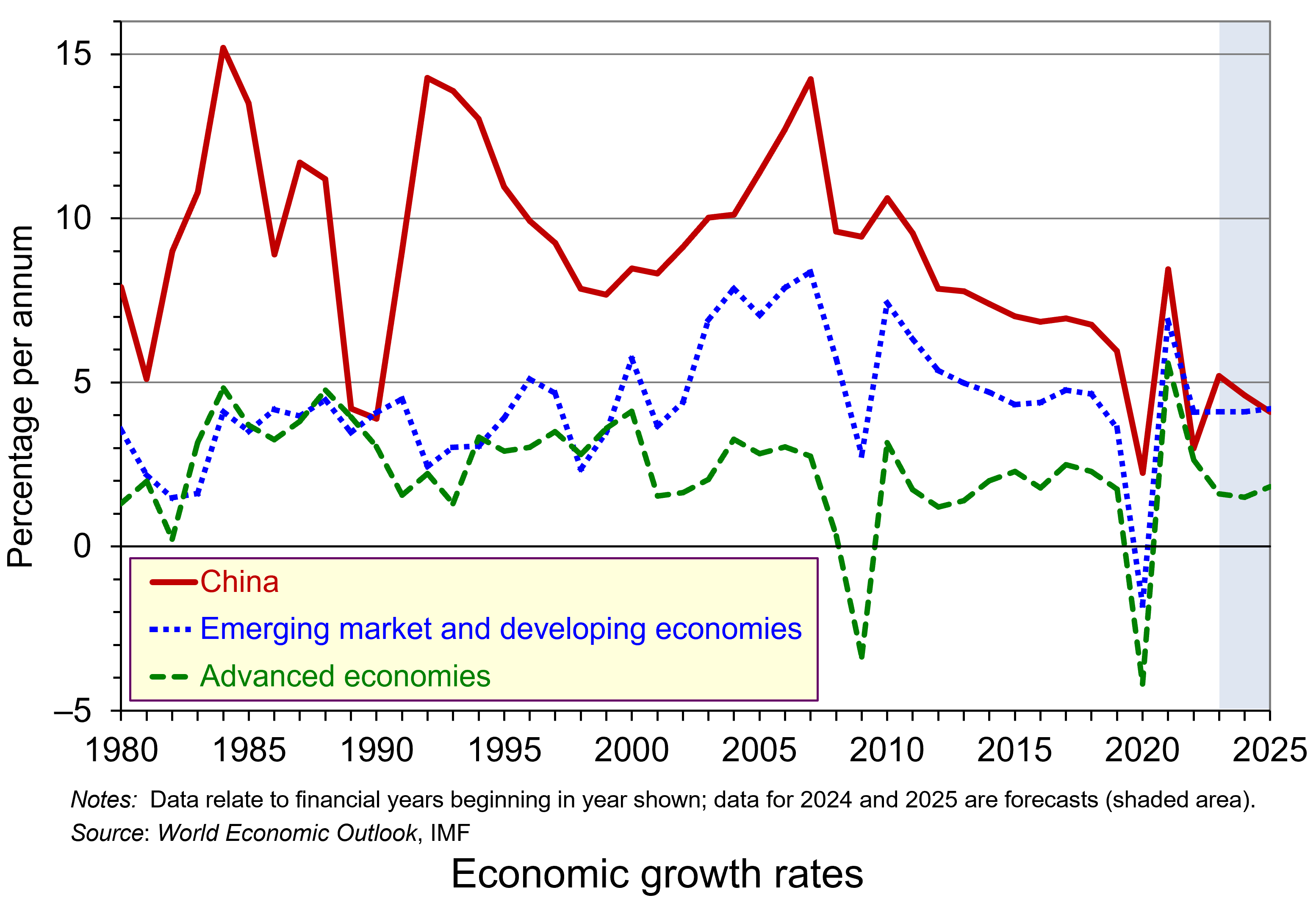 But in the past, Chinese growth was much higher and was a major driver of global growth. Over the period 1980 to 2018, Chinese economic growth averaged 9.5% – more than twice the average rate of developing countries (4.5%) and nearly four times the average rate of advanced countries (2.4%) (see chart – click here for a PowerPoint of the chart).
But in the past, Chinese growth was much higher and was a major driver of global growth. Over the period 1980 to 2018, Chinese economic growth averaged 9.5% – more than twice the average rate of developing countries (4.5%) and nearly four times the average rate of advanced countries (2.4%) (see chart – click here for a PowerPoint of the chart).
Not only is Chinese growth now much lower, but it is set to decline further. The IMF forecasts that in 2025, Chinese growth will have fallen to 4.1% – below the forecast developing-country average of 4.2% and well below that of India (6.5%).
Causes of slowing Chinese growth
There are a number of factors that have come together to contribute to falling economic growth rates – growth rates that otherwise would have been expected to be considerably higher as the Chinese economy reopened after severe Covid lockdowns.
 Property market
Property market
China has experienced a property boom over the past 20 years years as the government has encouraged construction in residential blocks and in factories and offices. The sector has accounted for some 20% of economic activity. But for many years, demand outstripped supply as consumers chose to invest in property, partly because of a lack of attractive alternatives for their considerable savings and partly because property prices were expected to go on rising. This lead to speculation on the part of both buyers and property developers. Consumers rushed to buy property before prices rose further and property developers borrowed considerably to buy land, which local authorities encouraged, as it provided a valuable source of revenue.
But now there is considerable overcapacity in the sector and new building has declined over the past three years. According to the IMF:
Housing starts have fallen by more than 60 per cent relative to pre-pandemic levels, a historically rapid pace only seen in the largest housing busts in cross-country experience in the last three decades. Sales have fallen amid homebuyer concerns that developers lack sufficient financing to complete projects and that prices will decline in the future.
As a result, many property developers have become unviable. At the end of January, the Chinese property giant, Evergrande, was ordered to liquidate by a Hong Kong court, after the judge ruled that the company did not have a workable plan to restructure around $300bn of debt. Over 50 Chinese property developers have defaulted or missed payments since 2020. The liquidation of Evergrande and worries about the viability of other Chinese property developers is likely to send shockwaves around the Chinese property market and more widely around Chinese investment markets.
Overcapacity
Rapid investment over many years has led to a large rise in industrial capacity. This has outstripped demand. The problem could get worse as investment, including state investment, is diverted from the property sector to manufacturing, especially electric vehicles. But with domestic demand dampened, this could lead to increased dumping on international markets – something that could spark trade wars with the USA and other trading partners (see below). Worries about this in China are increasing as the possibility of a second Trump presidency looks more possible. The Chinese authorities are keen to expand aggregate demand to tackle this overcapacity.
Uncertainty
Consumer and investor confidence are low. This is leading to severe deflationary pressures. If consumers face a decline in the value of their property, this wealth effect could further constrain their spending. This will, in turn, dampen industrial investment.
Uncertainty is beginning to affect foreign companies based in China. Many foreign companies are now making a loss in China or are at best breaking even. This could lead to disinvestment and add to deflationary pressures.
The Chinese stock market and policy responses
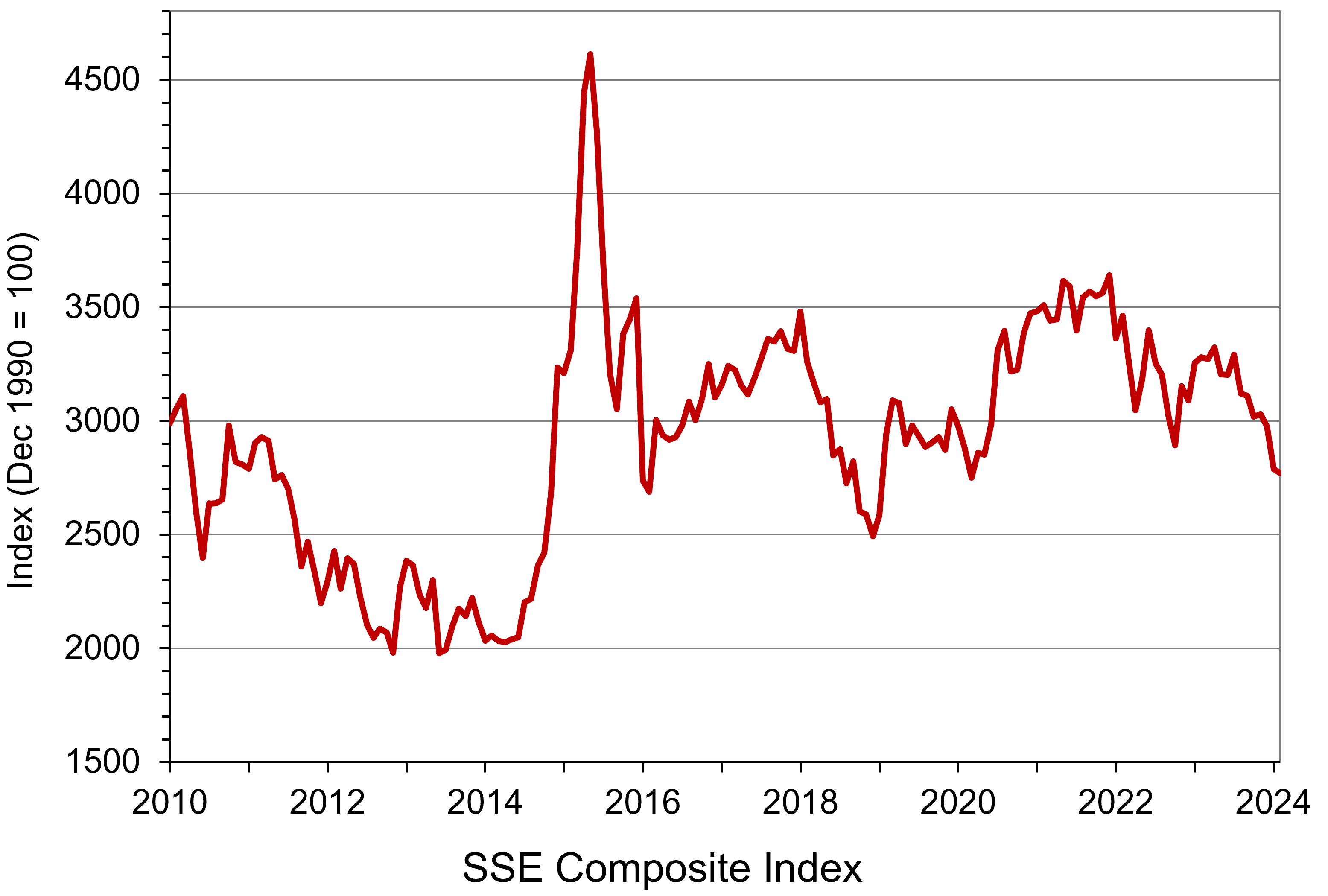 Lack of confidence in the Chinese economy is reflected in falling share prices. The Shanghai SSE Composite Index (an index of all stocks traded on the Shanghai Stock Exchange) has fallen dramatically in recent months. From a high of 3703 in September 2021, it had fallen to 2702 on 5 Feb 2024 – a fall of 27%. It is now below the level at the beginning of 2010 (see chart: click here for a PowerPoint). On 5 February alone, some 1800 stocks fell by over 10% in Shanghai and Shenzhen. People were sensing a rout and investors expressed their frustration and anger on social media, including the social media account of the US Embassy. The next day, the authorities intervened and bought large quantities of key stocks. China’s sovereign wealth fund announced that it would increase its purchase of shares to support the country’s stock markets. The SSE Composite rose 4.1% on 6 February and the Shenzhen Component Index rose 6.2%.
Lack of confidence in the Chinese economy is reflected in falling share prices. The Shanghai SSE Composite Index (an index of all stocks traded on the Shanghai Stock Exchange) has fallen dramatically in recent months. From a high of 3703 in September 2021, it had fallen to 2702 on 5 Feb 2024 – a fall of 27%. It is now below the level at the beginning of 2010 (see chart: click here for a PowerPoint). On 5 February alone, some 1800 stocks fell by over 10% in Shanghai and Shenzhen. People were sensing a rout and investors expressed their frustration and anger on social media, including the social media account of the US Embassy. The next day, the authorities intervened and bought large quantities of key stocks. China’s sovereign wealth fund announced that it would increase its purchase of shares to support the country’s stock markets. The SSE Composite rose 4.1% on 6 February and the Shenzhen Component Index rose 6.2%.
However, the rally eased as investors waited to see what more fundamental measures the authorities would take to support the stock markets and the economy more generally. Policies are needed to boost the wider economy and encourage a growth in consumer and business confidence.
Interest rates have been cut four times since the beginning of 2022, when the prime loan rate was cut from 3.85% to 3.7%. The last cut was from 3.55% to 3.45% in August 2023. But this has been insufficient to provide the necessary boost to aggregate demand. Further cuts in interest rates are possible and the government has said that it will use proactive fiscal and effective monetary policy in response to the languishing economy. However, government debt is already high, which limits the room for expansionary fiscal policy, and consumers are highly risk averse and have a high propensity to save.
Graduate unemployment
 China has seen investment in education as an important means of increasing human capital and growth. But with a slowing economy, there are are more young people graduating each year than there are graduate jobs available. Official data show that for the group aged 16–24, the unemployment rate was 14.9% in December. This compares with an overall urban unemployment rate of 5.1%. Many graduates are forced to take non-graduate jobs and graduate jobs are being offered at reduced salaries. This will have a further dampening effect on aggregate demand.
China has seen investment in education as an important means of increasing human capital and growth. But with a slowing economy, there are are more young people graduating each year than there are graduate jobs available. Official data show that for the group aged 16–24, the unemployment rate was 14.9% in December. This compares with an overall urban unemployment rate of 5.1%. Many graduates are forced to take non-graduate jobs and graduate jobs are being offered at reduced salaries. This will have a further dampening effect on aggregate demand.
Demographics
China’s one-child policy, which it pursued from 1980 to 2016, plus improved health and social care leading to greater longevity, has led to an ageing population and a shrinking workforce. This is despite recent increases in unemployment in the 16–24 age group. The greater the ratio of dependants to workers, the greater the brake on growth as taxes and savings are increasingly used to provide various forms of support.
Effects on the rest of the world
China has been a major driver of world economic growth. With a slowing Chinese economy, this will provide less stimulus to growth in other countries. Many multinational companies, including chip makers, cosmetics companies and chemical companies, earn considerable revenue from China. For example, the USA exports over $190 billion of goods and services to China and these support over 1 million jobs in the USA. A slowdown in China will have repercussions for many companies around the world.
There is also the concern that Chinese manufacturers may dump products on world markets at less than average (total) cost to shift stock and keep production up. This could undermine industry in many countries and could initiate a protectionist response. Already Donald Trump is talking about imposing a 10% tariff on most imported goods if he is elected again in November. Such tariffs could be considerably higher on imports from China. If Joe Biden is re-elected, he too may impose tariffs on Chinese goods if they are thought to be unfairly subsidised. US (and possibly EU) tariffs on Chinese goods could lead to a similar response from China, resulting in a trade war – a negative sum game.
Videos
Articles
- IMF Predicts China Economy Slowing Over Next Four Years
Voice of America, Evie Steele (2/2/24)
- China’s Real Estate Sector: Managing the Medium-Term Slowdown
IMF News, Henry Hoyle and Sonali Jain-Chandra (2/2/24)
- China braced for largest human migration on earth amid bleak economic backdrop
ITV News, Debi Edward (4/2/24)
- China’s property giant Evergrande ordered to liquidate as debt talks fail
Aljazeera (29/1/24)
- China’s overcapacity a challenge that is ‘here to stay’, says US chamber
Financial Times, Joe Leahy (1/2/24)
- China needs to learn lessons from 1990s Japan
Financial Times, Gillian Tett (1/2/24)
- The Trump factor is looming over China’s markets
Financial Times, Katie Martin (2/2/24)
- China’s many systemic problems dominate its outlook for 2024
The Guardian, George Magnus (1/1/24)
- China youth unemployment will stay elevated in 2024, but EIU warns economic impact will linger
CNBC, Clement Tan (25/1/24)
- Don’t count on a soft landing for the world economy – turbulence is ahead
The Guardian, Kenneth Rogoff (2/2/24)
- As falling stocks draw criticism in China, censors struggle to keep up
Washington Post, Lily Kuo (6/2/24)
- China’s doom loop: a dramatically smaller (and older) population could create a devastating global slowdown
The Conversation, Jose Caballero (12/2/24)
- China: why the country’s economy has hit a wall – and what it plans to do about it
The Conversation, Hong Bo (19/3/24)
- Confronting inflation and low growth
OECD Economic Outlook Interim Report (September 2023) (see especially Box 1)
Questions
- Why is China experiencing slowing growth and is growth likely to pick up over the next five years?
- How does the situation in China today compare with that in Japan 30 years ago?
- What policies could the Chinese government pursue to stimulate economic growth?
- What policies were enacted towards China during the Trump presidency from 2017 to 2020?
- Would you advise the Chinese central bank to cut interest rates further? Explain.
- Should China introduce generous child support for families, no matter the number of children?
 The traditional theory of the firm assumes that firms are profit maximisers. Although, in practice, decision-makers in firms are driven by a range of motives and objectives, profit remains a key objective for most firms – if not maximising profit, at least trying to achieve profit growth so as to satisfy shareholders, retain confidence in the company and prevent the share price from falling. After all, if the company is profitable, it is easier to fund investment, either from ploughed-back profit, borrowing or new share issue. And greater investment will help to drive profits in the future.
The traditional theory of the firm assumes that firms are profit maximisers. Although, in practice, decision-makers in firms are driven by a range of motives and objectives, profit remains a key objective for most firms – if not maximising profit, at least trying to achieve profit growth so as to satisfy shareholders, retain confidence in the company and prevent the share price from falling. After all, if the company is profitable, it is easier to fund investment, either from ploughed-back profit, borrowing or new share issue. And greater investment will help to drive profits in the future.
But does the pursuit of profit and shareholder value as the number-one objective actually lead to higher profit? It could be that a prime focus on other things such as consumer satisfaction, product design and value, innovation, safety, worker involvement and the local community could lead to greater long-term profit than an aggressive policy of marketing, cost cutting and financial rejigging – three of the commonest approaches to achieving greater profits.
Boeing disasters
In 2018 and 2019 there were two fatal crashes involving the new 737 MAX-8 aircraft. On 29 October 2018, Indonesia’s Lion Air Flight 610 crashed into the Java Sea; all 189 people on board died. On 10 March 2019, Ethiopian Airlines Flight 302 similarly crashed; all 157 people on board died. Both disasters were the result of a faulty automatic manoeuvring system. The company and its CEO, Dennis Muilenburg, knew about issues with the system, but preferred to keep planes flying while they sought to fix the issue. Grounding them would have cost the company money. But taking this gamble led to two fatal crashes. This damaged the company’s reputation and cost it billions of dollars.
 The US Securities and Exchange Commission (SEC) investigated the cases and found that the company had made false statements about the plane’s safety and had put ‘profits before people’. But putting profits first ended up in a huge fall in profits, with the 737 MAX grounded for 20 months.
The US Securities and Exchange Commission (SEC) investigated the cases and found that the company had made false statements about the plane’s safety and had put ‘profits before people’. But putting profits first ended up in a huge fall in profits, with the 737 MAX grounded for 20 months.
Since the crashes there have been several other issues with various critical systems, including stabilisation, engines, flight control systems, hydraulics and wiring. In December 2023, Boeing asked airlines to inspect its 737 MAX planes for a potential loose bolt in the rudder control system.
On 5 January 2024, Alaska Airlines Flight 1282 experienced an emergency. A window panel on the 737 MAX-9 aircraft, which replaced an unused emergency exit door, blew out and the cabin depressurised. Fortunately the plane was still climbing and had reached only just under 5000m – less than half of the cruising altitude of over 11 500m. The plane rapidly descended and safely returned to Portland International Airport without loss of life. Had the incident occurred at cruising altitude, the rush of air out of the plane would have been much greater. Passengers would be less likely to be wearing their seat belts and several people could have been sucked out.
The Federal Aviation Administration (FAA) temporarily grounded 171 MAX-9s for inspections. It found that several planes had loose bolts holding the panels in place and could potentially have suffered similar blow outs.
Profits rather than safety?
Critics have claimed that the corporate culture at Boeing prioritised profit over safety. This was made worse in 2001 when company headquarters moved from Seattle to Chicago but production remained at Seattle. The culture at headquarters became sharply focused on financial success. Boeing was under intense competition from Airbus, which announced its more fuel-efficient version of the A320, the A320neo, in 2010, with launch planned for 2015. Boeing’s more fuel-efficient version of the 737, the 737 MAX, was announced in 2011, scheduled for first delivery in 2017. Since then, Boeing has been keen to get the 737 MAX to customers as quickly as possible. Also, Boeing has sought to cut manufacturing costs to keep prices competitive with Airbus.
Despite warnings from some Boeing employees that this competition was leading to corners being cut that compromised safety, Boeing management continued to push for more rapid and cheaper production to fight the competition from Airbus.
The aircraft industry is regulated in the USA by the Federal Aviation Administration (FAA). In 2020, the House Committee on Transportation and Infrastructure produced a detailed report on the industry. It found that the FAA delegated too much safety certification work to Boeing. This was a case of regulatory capture. It was also accused of sharing the goal of promoting the production of US-based Boeing in its competition with European-based Airbus.
Effects on profits
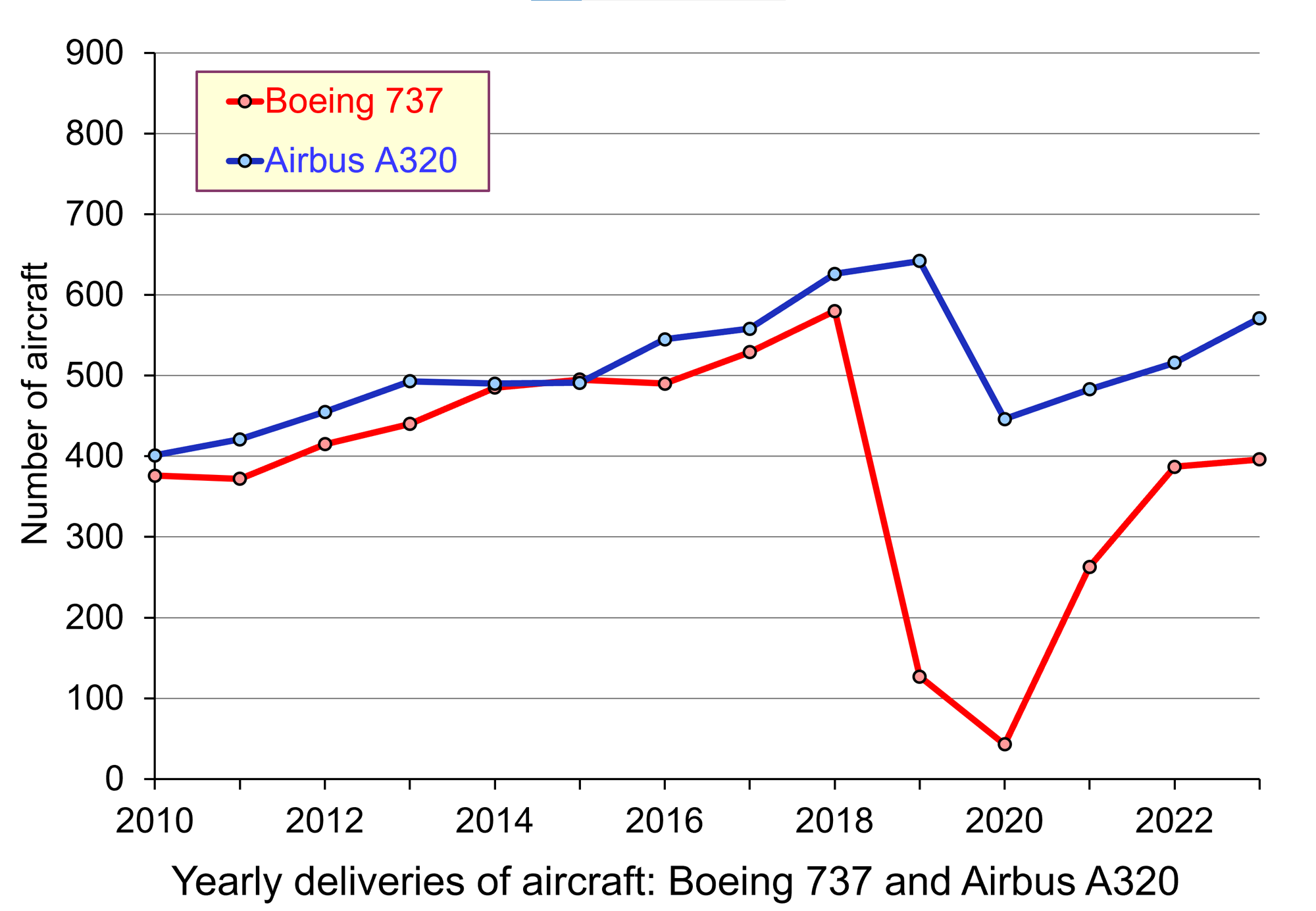 But rather than a focus on profit leading to greater profits, safety issues have led to groundings of 737s, a fall in sales and a fall in profits. The first chart shows deliveries of 737s slightly lagging A320s from 2010 to 2018. Since then deliveries of 737s have fallen well behind A320s. In terms of orders for all planes, Boeing was ahead of Airbus in 2018 (893 compared with 747). Since then, Boeing has significantly lagged behind Airbus and in 2019 and 2020 cancellations exceeded new orders. The January 2024 incident and subsequent groundings are likely to erode confidence, orders and profits even further.
But rather than a focus on profit leading to greater profits, safety issues have led to groundings of 737s, a fall in sales and a fall in profits. The first chart shows deliveries of 737s slightly lagging A320s from 2010 to 2018. Since then deliveries of 737s have fallen well behind A320s. In terms of orders for all planes, Boeing was ahead of Airbus in 2018 (893 compared with 747). Since then, Boeing has significantly lagged behind Airbus and in 2019 and 2020 cancellations exceeded new orders. The January 2024 incident and subsequent groundings are likely to erode confidence, orders and profits even further.
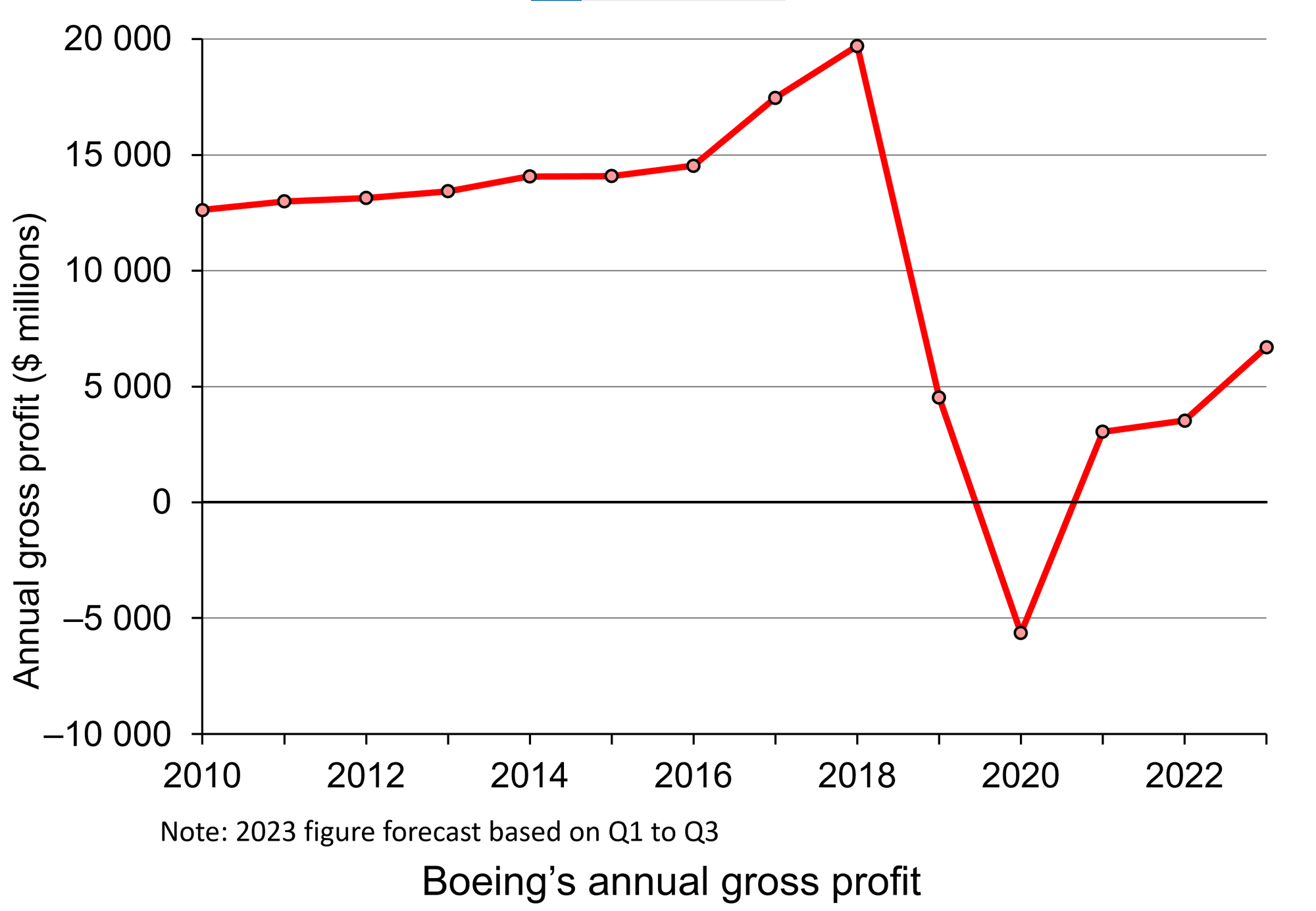 As you can see from the second chart, profits fell substantially in 2019, and with COVID fell again in 2020. They have not recovered to previous levels since. Depending on how the market responds to the issue of loose panel bolts on the MAX-9, profits could well fall again in 2024. There will almost certainly be a further erosion of confidence and probably of orders.
As you can see from the second chart, profits fell substantially in 2019, and with COVID fell again in 2020. They have not recovered to previous levels since. Depending on how the market responds to the issue of loose panel bolts on the MAX-9, profits could well fall again in 2024. There will almost certainly be a further erosion of confidence and probably of orders.
The Boeing story is a salutary lesson in how not to achieve long-term profit. A focus on design, quality and reliability may be a better means to achieving long-term profit growth than trying to appeal to shareholders by increasing short-term profits through aggressive cost cutting and hoping that this will not affect quality.
Video and audio
Articles
- ‘All those agencies failed us’: inside the terrifying downfall of Boeing
The Guardian, Charles Bramesco (22/2/22)
- A terrifying 10 minute flight adds to years of Boeing’s quality control problems
CNN, Chris Isidore (8/1/24)
- When A Company Prioritizes Profit Over People: Boeing CEO Tells Congress That Safety Is ‘Not Our Business Model’
Forbes, Jack Kelly (30/10/19)
- ‘Boeing played Russian roulette with people’s lives’
BBC News, Theo Leggett and Tom Burridge (November 2020)
- 737 Max: Boeing refutes new safety concerns
BBC News, Theo Leggett (26/11/21)
- 737 Max: Boeing to pay $200m over charges it misled investors
BBC News, Monica Miller (23/9/22)
- Boeing’s mid-flight blowout a big problem for company
BBC News, Theo Leggett (8/1/24)
- Boeing: US regulator to increase oversight of firm after blowout
BBC News (12/1/24)
- Boeing’s 737 Max Is a Saga of Capitalism Gone Awry
International New York Times, via Deccan Herald, David Gelles (24/11/20)
- Boeing and a dramatic change of direction
johnkay.com, John Kay (10/12/03)
- Congressional report faults Boeing, FAA for 737 Max failures, just as regulators close in on recertification
CNBC, Leslie Josephs (16/9/20)
- Boeing 737 Max: The FAA wanted a safe plane – but didn’t want to hurt America’s biggest exporter either
The Conversation, Susan Webb Yackee and Simon F Haeder (22/3/19)
- Boeing needs to get real: the 737 Max should probably be scrapped
The Conversation, ManMohan S Sodhi (12/1/24)
- Boeing: How much trouble is the company in?
BBC News, Theo Leggett (17/3/24)
Information
Questions
- Why is the pursuit of long-run profit likely to result in different decisions from the pursuit of short-run profit?
- How has Airbus’s strategy differed from that of Boeing?
- How would you summarise Boeing management’s attitude towards risk?
- Is it important to locate senior management of a company at its manufacturing base?
- What is regulatory capture? Is it fair to say that the FAA was captured by Boeing?
- Should Boeing scrap the 737 MAX and design a new narrow-body plane?
 A happy New Year for 2024. Let’s hope that the coming year brings some good news amidst all the the gloom of war, squeezed living standards, the effects of climate change and the rise of authoritarian regimes.
A happy New Year for 2024. Let’s hope that the coming year brings some good news amidst all the the gloom of war, squeezed living standards, the effects of climate change and the rise of authoritarian regimes.
One piece of good news is the growth in environmental debt swaps in developing countries. These are known as debt-for-nature swaps (or debt-for-environment swaps or green debt swaps). As Case Study 26.16 in Economics (11th edition) and Case Study 15.19 in Essentials of Economics (9th edition) explain:
A debt-for-nature swap is where debts are cancelled in return for investment in environmental projects, including protecting biodiversity, reducing carbon emissions and mitigating the effect of climate change. There are two types of scheme: bilateral and commercial.
In a bilateral swap, a creditor country agrees to cancel debt in return for the debtor country investing a proportion of the amount in environmental projects. In a commercial swap, the debt owed to banks is sold to an international environmental agency at a substantial discount (or sometimes even given away); the agency then agrees to cancel this debt in return for the country funding the agency to carry out various environmental projects.
The first debt-for-nature swap was made as far back as 1987, when environmental NGO, Conservation International, arranged for Bolivia to be forgiven $650 000 of its debt in exchange for the establishment of three conservation areas bordering the Beni Reserve (see either of the above case studies). In the 1990s and 2000s, debt-for nature swaps became popular with creditors and by 2010, the total debt cancelled through debt-for-nature swaps was just over $1 billion.
However, the popularity waned in the 2010s and with COVID, many developing countries were diverting resources from long-term sustainability and mitigating the effects of climate change to emergency healthcare and relief.
 More recently, debt-for-for nature swaps have become popular again.
More recently, debt-for-for nature swaps have become popular again.
In May 2023, Ecuador benefited from the biggest debt swap to that point. The agreement saw $1.6bn of its commercial debt refinanced at a discount in exchange for large-scale conservation in and around the Galápagos Islands. At least $12m per year of the money saved will be channelled into conservation in the archipelago, with its unique flora and fauna.
Such projects are set to increase, with potentially significant beneficial effects for biodiversity, climate and the environment generally. At the COP28 summit in December 2023, a task force was set up by a group of multilateral development banks to promote an increase in the size and number of debt-for-nature swaps.
According to the Organisation for Economic Co-operation and Development (OECD), developing economies will need an annual $2.4 trillion of investment in climate action in the coming years. So far, the market for debt-for-nature swaps is set to rise to around $800bn. If they are to make a significant contribution to tackling climate change and loss of biodiversity, they need to be scaled up massively, especially as the cost of servicing debt has risen with higher global interest rates.
Nevertheless, as part of a portfolio of measures to tackle debt, climate change, loss of biodiversity and damage to the environment more generally, they are making an important contribution – a contribution that is set to rise.
Video and Webinar
Articles
Questions
- Identify other types of debt swap and discuss their importance.
- Why are debt-for-nature debt swaps in the interests of debtor countries, creditors and the world generally?
- What is ‘green washing’? How may debt-for-nature swaps be assessed to prevent such green washing?
- Why are many developing countries’ debt burdens skyrocketing?
- Why may a developing country’s solution to its growing debt be detrimental to the environment?
- Assess the Belize debt-swap deal in tackling both its debt and conservation.
 Latest figures from the Office for National Statistics show that the UK was in recession at the end of 2023. The normal definition of recession is two quarters of falling real GDP. This is what happened to the UK in the last two quarters of 2023, with GDP falling by 0.1% in Q3 and 0.3% in Q4. In Q4, output of the service industries fell by 0.2%, production industries by 1.0% and construction by 1.3%.
Latest figures from the Office for National Statistics show that the UK was in recession at the end of 2023. The normal definition of recession is two quarters of falling real GDP. This is what happened to the UK in the last two quarters of 2023, with GDP falling by 0.1% in Q3 and 0.3% in Q4. In Q4, output of the service industries fell by 0.2%, production industries by 1.0% and construction by 1.3%. For 2023 as a whole, while real GDP rose by 0.20%, real GDP per head fell by 0.67%. In the last two quarters of 2023, while real GDP fell by 0.1% and 0.3% respectively, real GDP per head fell by 0.4% and 0.6%, respectively, having already fallen in each of the previous five quarters. Chart 1 shows real GDP growth and real GDP growth per head from 2007 to 2023 (click here for a PowerPoint). As you can see, given population growth, real GDP per head has consistently grown slower than real GDP.
For 2023 as a whole, while real GDP rose by 0.20%, real GDP per head fell by 0.67%. In the last two quarters of 2023, while real GDP fell by 0.1% and 0.3% respectively, real GDP per head fell by 0.4% and 0.6%, respectively, having already fallen in each of the previous five quarters. Chart 1 shows real GDP growth and real GDP growth per head from 2007 to 2023 (click here for a PowerPoint). As you can see, given population growth, real GDP per head has consistently grown slower than real GDP. This compares unfavourably with the period from 1994 to 2007, when the average annual rate of growth of real GDP was 3.0% and that of real GDP per head was 2.5%.
This compares unfavourably with the period from 1994 to 2007, when the average annual rate of growth of real GDP was 3.0% and that of real GDP per head was 2.5%. This is a key issue for the government – how to encourage a growth in productivity. The UK’s record of productivity growth has been poor since 2008. The period from 1996 to 2006 saw an average annual growth in labour productivity of 6.4%. Since then, however, labour productivity has grown by an average annual rate of only 0.3%. This is illustrated in Chart 3 (click here for a PowerPoint). If the pre-2007 rate had continued to the end of 2023, labour productivity would be 189% higher. This would have made GDP per head today substantially higher. If GDP per head is to grow faster, then the underlying issue of a poor growth in labour productivity will need to be addressed.
This is a key issue for the government – how to encourage a growth in productivity. The UK’s record of productivity growth has been poor since 2008. The period from 1996 to 2006 saw an average annual growth in labour productivity of 6.4%. Since then, however, labour productivity has grown by an average annual rate of only 0.3%. This is illustrated in Chart 3 (click here for a PowerPoint). If the pre-2007 rate had continued to the end of 2023, labour productivity would be 189% higher. This would have made GDP per head today substantially higher. If GDP per head is to grow faster, then the underlying issue of a poor growth in labour productivity will need to be addressed. The top 1% of income earners’ share of disposable income is just under 9.0%. (Note that disposable income is after income taxes have been deducted and includes cash benefits and is thus more equally distributed than original income.)
The top 1% of income earners’ share of disposable income is just under 9.0%. (Note that disposable income is after income taxes have been deducted and includes cash benefits and is thus more equally distributed than original income.) But, public finances have been under pressure in recent years, especially from COVID support measures. General government gross debt has risen from 27.7% of GDP in 1990/91 to 99.4% in 2022/23. This is illustrated in Chart 4 (click here for a PowerPoint). Although it has fallen from the peak of 107.6% of GDP in 2020/21 (during the COVID pandemic), according to the Office for Budget Responsibility it is set to rise again, peaking at 103.8% in 2026/27. There is thus pressure on the government to reduce public-sector borrowing, not increase it. This makes it difficult to finance public investment or tax cuts.
But, public finances have been under pressure in recent years, especially from COVID support measures. General government gross debt has risen from 27.7% of GDP in 1990/91 to 99.4% in 2022/23. This is illustrated in Chart 4 (click here for a PowerPoint). Although it has fallen from the peak of 107.6% of GDP in 2020/21 (during the COVID pandemic), according to the Office for Budget Responsibility it is set to rise again, peaking at 103.8% in 2026/27. There is thus pressure on the government to reduce public-sector borrowing, not increase it. This makes it difficult to finance public investment or tax cuts. The output of some goods and services goes unrecorded. As we note in Economics, 11e (section 15.2), “If you employ a decorator to paint your living room, this will be recorded in the GDP statistics. If, however, you paint the room yourself, it will not. Similarly, if a childminder is employed by parents to look after their children, this childcare will form part of GDP. If, however, a parent stays at home to look after the children, it will not.
The output of some goods and services goes unrecorded. As we note in Economics, 11e (section 15.2), “If you employ a decorator to paint your living room, this will be recorded in the GDP statistics. If, however, you paint the room yourself, it will not. Similarly, if a childminder is employed by parents to look after their children, this childcare will form part of GDP. If, however, a parent stays at home to look after the children, it will not. Large amounts of production and consumption involve external costs to the environment and to other people. These externalities are not included in the calculation of GDP.
Large amounts of production and consumption involve external costs to the environment and to other people. These externalities are not included in the calculation of GDP. Some of the undesirable effects of growth may in fact increase GDP! Take the examples of crime, stress-related illness and environmental damage. Faster growth may lead to more of all three. But increased crime leads to more expenditure on security; increased stress leads to more expenditure on health care; and increased environmental damage leads to more expenditure on environmental clean-up. These expenditures add to GDP. Thus, rather than reducing GDP, crime, stress and environmental damage actually increase it.
Some of the undesirable effects of growth may in fact increase GDP! Take the examples of crime, stress-related illness and environmental damage. Faster growth may lead to more of all three. But increased crime leads to more expenditure on security; increased stress leads to more expenditure on health care; and increased environmental damage leads to more expenditure on environmental clean-up. These expenditures add to GDP. Thus, rather than reducing GDP, crime, stress and environmental damage actually increase it. The PCI comprises 42 indicators under eight headings: human capital, natural capital, information and communication technology (ICT), structural change (the movement of labour and other productive resources from low-productivity to high-productivity economic activities), transport infrastructure, institutions (political, legal and financial) and the private sector (ease of starting businesses, availability of credit, ease of cross-border trade, etc.). It covers 194 economies since 2000 (currently to 2022). As UNCTAD states, ‘The PCI can help diagnose the areas where countries may be leading or falling behind, spotlighting where policies are working and where corrective efforts are needed.’ Chart 5 shows the PCI for various economies from 2000 to 2022 (click here for a PowerPoint).
The PCI comprises 42 indicators under eight headings: human capital, natural capital, information and communication technology (ICT), structural change (the movement of labour and other productive resources from low-productivity to high-productivity economic activities), transport infrastructure, institutions (political, legal and financial) and the private sector (ease of starting businesses, availability of credit, ease of cross-border trade, etc.). It covers 194 economies since 2000 (currently to 2022). As UNCTAD states, ‘The PCI can help diagnose the areas where countries may be leading or falling behind, spotlighting where policies are working and where corrective efforts are needed.’ Chart 5 shows the PCI for various economies from 2000 to 2022 (click here for a PowerPoint). The MNW programme was established in 2010. This has resulted in Office for National Statistics developing new measures of national well-being. The ONS produces statistical bulletins and datasets with its latest results.
The MNW programme was established in 2010. This has resulted in Office for National Statistics developing new measures of national well-being. The ONS produces statistical bulletins and datasets with its latest results. World at One (from 7’00” to 25’14”)
World at One (from 7’00” to 25’14”) On 12 February, it was announced that
On 12 February, it was announced that  The Body Shop was founded in 1976 and shot to fame in the 1980s. It stood for environmental awareness and an ethical approach to business. But its success had as much to do with what it sold as what it stood for. It sold natural cosmetics – Raspberry Ripple Bathing Bubbles and Camomile Shampoo – products that proved immensely popular with consumers.
The Body Shop was founded in 1976 and shot to fame in the 1980s. It stood for environmental awareness and an ethical approach to business. But its success had as much to do with what it sold as what it stood for. It sold natural cosmetics – Raspberry Ripple Bathing Bubbles and Camomile Shampoo – products that proved immensely popular with consumers. The growth strategy of The Body Shop focused upon developing a distinctive and highly innovative product range, and at the same time identifying these products with major social issues of the day, such as the environment and animal rights.
The growth strategy of The Body Shop focused upon developing a distinctive and highly innovative product range, and at the same time identifying these products with major social issues of the day, such as the environment and animal rights. Anita Roddick, however, believed that, by taking over The Body Shop, L’Oréal would develop a more ethical approach to business. Indeed, it did publicly recognise that it needed to develop its ethical and environmental policies.
Anita Roddick, however, believed that, by taking over The Body Shop, L’Oréal would develop a more ethical approach to business. Indeed, it did publicly recognise that it needed to develop its ethical and environmental policies. Sadly, Anita Roddick died in 2007 and so was not able to witness these changes.
Sadly, Anita Roddick died in 2007 and so was not able to witness these changes. From 2013, the financial performance of The Body Shop deteriorated. Profits fell by 38% in 2016 to just €34m, with sales falling by 5%. In June 2017, L’Oréal announced that it had agreed to sell The Body Shop for €1bn (£877m) to
From 2013, the financial performance of The Body Shop deteriorated. Profits fell by 38% in 2016 to just €34m, with sales falling by 5%. In June 2017, L’Oréal announced that it had agreed to sell The Body Shop for €1bn (£877m) to  According to
According to  But in the past, Chinese growth was much higher and was a major driver of global growth. Over the period 1980 to 2018, Chinese economic growth averaged 9.5% – more than twice the average rate of developing countries (4.5%) and nearly four times the average rate of advanced countries (2.4%) (see chart – click
But in the past, Chinese growth was much higher and was a major driver of global growth. Over the period 1980 to 2018, Chinese economic growth averaged 9.5% – more than twice the average rate of developing countries (4.5%) and nearly four times the average rate of advanced countries (2.4%) (see chart – click  Property market
Property market Lack of confidence in the Chinese economy is reflected in falling share prices. The Shanghai SSE Composite Index (an index of all stocks traded on the Shanghai Stock Exchange) has fallen dramatically in recent months. From a high of 3703 in September 2021, it had fallen to 2702 on 5 Feb 2024 – a fall of 27%. It is now below the level at the beginning of 2010 (see chart: click
Lack of confidence in the Chinese economy is reflected in falling share prices. The Shanghai SSE Composite Index (an index of all stocks traded on the Shanghai Stock Exchange) has fallen dramatically in recent months. From a high of 3703 in September 2021, it had fallen to 2702 on 5 Feb 2024 – a fall of 27%. It is now below the level at the beginning of 2010 (see chart: click  China has seen investment in education as an important means of increasing human capital and growth. But with a slowing economy, there are are more young people graduating each year than there are graduate jobs available. Official data show that for the group aged 16–24, the unemployment rate was 14.9% in December. This compares with an overall urban unemployment rate of 5.1%. Many graduates are forced to take non-graduate jobs and graduate jobs are being offered at reduced salaries. This will have a further dampening effect on aggregate demand.
China has seen investment in education as an important means of increasing human capital and growth. But with a slowing economy, there are are more young people graduating each year than there are graduate jobs available. Official data show that for the group aged 16–24, the unemployment rate was 14.9% in December. This compares with an overall urban unemployment rate of 5.1%. Many graduates are forced to take non-graduate jobs and graduate jobs are being offered at reduced salaries. This will have a further dampening effect on aggregate demand. The traditional theory of the firm assumes that firms are profit maximisers. Although, in practice, decision-makers in firms are driven by a range of motives and objectives, profit remains a key objective for most firms – if not maximising profit, at least trying to achieve profit growth so as to satisfy shareholders, retain confidence in the company and prevent the share price from falling. After all, if the company is profitable, it is easier to fund investment, either from ploughed-back profit, borrowing or new share issue. And greater investment will help to drive profits in the future.
The traditional theory of the firm assumes that firms are profit maximisers. Although, in practice, decision-makers in firms are driven by a range of motives and objectives, profit remains a key objective for most firms – if not maximising profit, at least trying to achieve profit growth so as to satisfy shareholders, retain confidence in the company and prevent the share price from falling. After all, if the company is profitable, it is easier to fund investment, either from ploughed-back profit, borrowing or new share issue. And greater investment will help to drive profits in the future. The US Securities and Exchange Commission (SEC) investigated the cases and found that the company had made false statements about the plane’s safety and had put ‘profits before people’. But putting profits first ended up in a huge fall in profits, with the 737 MAX grounded for 20 months.
The US Securities and Exchange Commission (SEC) investigated the cases and found that the company had made false statements about the plane’s safety and had put ‘profits before people’. But putting profits first ended up in a huge fall in profits, with the 737 MAX grounded for 20 months.  But rather than a focus on profit leading to greater profits, safety issues have led to groundings of 737s, a fall in sales and a fall in profits. The first chart shows deliveries of 737s slightly lagging A320s from 2010 to 2018. Since then deliveries of 737s have fallen well behind A320s. In terms of orders for all planes, Boeing was ahead of Airbus in 2018 (893 compared with 747). Since then, Boeing has significantly lagged behind Airbus and in 2019 and 2020 cancellations exceeded new orders. The January 2024 incident and subsequent groundings are likely to erode confidence, orders and profits even further.
But rather than a focus on profit leading to greater profits, safety issues have led to groundings of 737s, a fall in sales and a fall in profits. The first chart shows deliveries of 737s slightly lagging A320s from 2010 to 2018. Since then deliveries of 737s have fallen well behind A320s. In terms of orders for all planes, Boeing was ahead of Airbus in 2018 (893 compared with 747). Since then, Boeing has significantly lagged behind Airbus and in 2019 and 2020 cancellations exceeded new orders. The January 2024 incident and subsequent groundings are likely to erode confidence, orders and profits even further. As you can see from the second chart, profits fell substantially in 2019, and with COVID fell again in 2020. They have not recovered to previous levels since. Depending on how the market responds to the issue of loose panel bolts on the MAX-9, profits could well fall again in 2024. There will almost certainly be a further erosion of confidence and probably of orders.
As you can see from the second chart, profits fell substantially in 2019, and with COVID fell again in 2020. They have not recovered to previous levels since. Depending on how the market responds to the issue of loose panel bolts on the MAX-9, profits could well fall again in 2024. There will almost certainly be a further erosion of confidence and probably of orders. A happy New Year for 2024. Let’s hope that the coming year brings some good news amidst all the the gloom of war, squeezed living standards, the effects of climate change and the rise of authoritarian regimes.
A happy New Year for 2024. Let’s hope that the coming year brings some good news amidst all the the gloom of war, squeezed living standards, the effects of climate change and the rise of authoritarian regimes. More recently, debt-for-for nature swaps have become popular again.
More recently, debt-for-for nature swaps have become popular again.